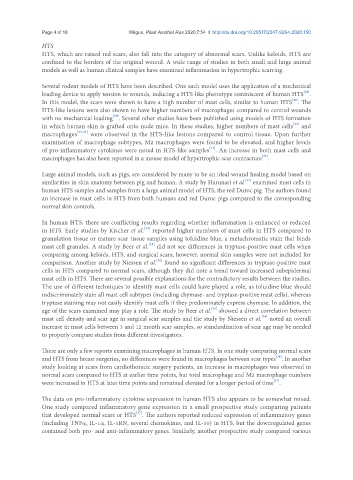Page 625 - Read Online
P. 625
Page 4 of 18 Wilgus. Plast Aesthet Res 2020;7:54 I http://dx.doi.org/10.20517/2347-9264.2020.150
HTS
HTS, which are raised red scars, also fall into the category of abnormal scars. Unlike keloids, HTS are
confined to the borders of the original wound. A wide range of studies in both small and large animal
models as well as human clinical samples have examined inflammation in hypertrophic scarring.
Several rodent models of HTS have been described. One such model uses the application of a mechanical
[28]
loading device to apply tension to wounds, inducing a HTS-like phenotype reminiscent of human HTS .
[28]
In this model, the scars were shown to have a high number of mast cells, similar to human HTS . The
HTS-like lesions were also shown to have higher numbers of macrophages compared to control wounds
with no mechanical loading . Several other studies have been published using models of HTS formation
[29]
[30]
in which human skin is grafted onto nude mice. In these studies, higher numbers of mast cells and
macrophages [30,31] were observed in the HTS-like lesions compared to control tissue. Upon further
examination of macrophage subtypes, M2 macrophages were found to be elevated, and higher levels
[31]
of pro-inflammatory cytokines were noted in HTS-like samples . An increase in both mast cells and
[32]
macrophages has also been reported in a mouse model of hypertrophic scar contracture .
Large animal models, such as pigs, are considered by many to be an ideal wound healing model based on
similarities in skin anatomy between pig and human. A study by Harunari et al. examined mast cells in
[33]
human HTS samples and samples from a large animal model of HTS, the red Duroc pig. The authors found
an increase in mast cells in HTS from both humans and red Duroc pigs compared to the corresponding
normal skin controls.
In human HTS, there are conflicting results regarding whether inflammation is enhanced or reduced
in HTS. Early studies by Kischer et al. reported higher numbers of mast cells in HTS compared to
[34]
granulation tissue or mature scar tissue samples using toluidine blue, a metachromatic stain that binds
[35]
mast cell granules. A study by Beer et al. did not see differences in tryptase-positive mast cells when
comparing among keloids, HTS, and surgical scars; however, normal skin samples were not included for
[36]
comparison. Another study by Niessen et al. found no significant differences in tryptase-positive mast
cells in HTS compared to normal scars, although they did note a trend toward increased subepidermal
mast cells in HTS. There are several possible explanations for the contradictory results between the studies.
The use of different techniques to identify mast cells could have played a role, as toluidine blue should
indiscriminately stain all mast cell subtypes (including chymase- and tryptase-positive mast cells), whereas
tryptase staining may not easily identify mast cells if they predominately express chymase. In addition, the
[35]
age of the scars examined may play a role. The study by Beer et al. showed a direct correlation between
[36]
mast cell density and scar age in surgical scar samples and the study by Niessen et al. noted an overall
increase in mast cells between 3 and 12 month scar samples, so standardization of scar age may be needed
to properly compare studies from different investigators.
There are only a few reports examining macrophages in human HTS. In one study comparing normal scars
[36]
and HTS from breast surgeries, no differences were found in macrophages between scar types . In another
study looking at scars from cardiothoracic surgery patients, an increase in macrophages was observed in
normal scars compared to HTS at earlier time points, but total macrophage and M2 macrophage numbers
[37]
were increased in HTS at later time points and remained elevated for a longer period of time .
The data on pro-inflammatory cytokine expression in human HTS also appears to be somewhat mixed.
One study compared inflammatory gene expression in a small prospective study comparing patients
[37]
that developed normal scars or HTS . The authors reported reduced expression of inflammatory genes
(including TNFα, IL-1α, IL-1RN, several chemokines, and IL-10) in HTS, but the downregulated genes
contained both pro- and anti-inflammatory genes. Similarly, another prospective study compared various

